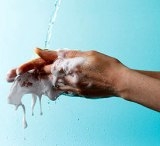Posts Tagged: pathogens
Foodborne illnesses and the 100K Genome Project

Bart Weimer, professor in the UC Davis School of Veterinary Medicine, serves as director of the 100K Genome Project and co-director of the recently established BGI@UC Davis facility, where the sequencing will be done. Other collaborators include the U.S. Centers for Disease Control and Prevention and the U.S. Department of Agriculture.
The new five-year microbial pathogen project focuses on making the food supply safer for consumers. The group will build a free, public database including sequence information for each pathogen's genome — the complete collection of its hereditary information. The database will contain the genomes of important foodborne pathogens including Salmonella, Listeria, and E. coli, as well as the most common foodborne and waterborne viruses that sicken people and animals.
The project will provide a roadmap for developing tests to identify pathogens and help trace their origins more quickly. The new genome database also will enable scientists to make discoveries that can be used to develop new methods for controlling disease-causing bacteria in the food chain.
"This landmark project will revolutionize our basic understanding of these disease-causing microorganisms," said Harris Lewin, vice chancellor for research at UC Davis.
The sequencing project is critically important for tackling the continuing outbreaks of often-deadly foodborne diseases around the world. In the United States alone, foodborne diseases annually sicken 48 million people and kill 3,000, according to the CDC.
"The lack of information about food-related bacterial genomes is hindering the research community's ability to improve the safety and security of the world food supply," Weimer said. "The data provided by the 100K Genome Project will make diagnostic tests quicker, more reliable, more accurate and more cost-effective."
"We see this project as a way to improve quality of life for a great many people, while minimizing a major business risk for food producers and distributors," said Mike McMullen, president of Agilent’s Chemical Analysis Group.
A consumer-focused article about the project is available on the FDA website.
(This article was condensed from a UC Davis news release. Read the full press release and watch a video of Bart Weimer giving an overview of the project.)
Food, hand-washing and the ick factor

There are many good reasons to wash hands:
- Pathogen spread – from yourself, from others, from one contaminated food to another (meats, produce, etc.)
- Chemical spread – whatever chemicals are on your hands can go directly into the food being prepared. This can include pesticides, hand sanitizers (ick), cleaning products, hand lotions, etc.
- The ick factor – “Ick, what’s that slime on your hands and do I really want that in my food?”
The most memorable item I learned about hand-washing is that we need to wash for at least 20 seconds — the time it takes to sing the entire “happy birthday song” twice (and slowly). Watch anyone in any kitchen or public bathroom, and very few come close to washing for that long.
It’s human nature to think that our own hands are cleaner than everyone else’s, and that maybe we ourselves have less need to wash our own hands before preparing food for others. Well, everyone benefits if we all wash our hands well before cooking or eating.
Many years ago I got giardia, which laid me out for weeks, and my doctor and I determined that I probably got it from a food-service worker who did not wash hands properly. A big “ick.” It was a real wake-up call about the need for hand-washing.
So, if you hear me singing the happy birthday song while washing my hands in the kitchen, you can be thankful for my commitment to good hygiene.
Guidelines for hand-washing
- Wet your hands with clean running water
- Apply liquid, bar, or powder soap
- Lather well
- Rub your hands vigorously for at least 20 seconds. Remember to scrub all surfaces, including the backs of your hands, wrists, between your fingers and under your fingernails
- Rinse well
- Dry your hands with a CLEAN or disposable towel or air dryer
- If possible, use your towel to turn off the faucet
(Information on hand-washing and using hand sanitizers can be found at the information sources below.)
Information sources for handwashing
- The Mayo Clinic
- The Centers for Disease Control and Prevention (CDC)
- CDC downloadable poster
- World Health Organization (WHO)
- WHO downloadable poster
Lastly, while we’re addressing kitchen sanitation, please use a clean tasting spoon each time you sample what you are cooking. It’s a really big ICK to taste from the stirring spoon, then put it back into the food. It’s also a way to spread germs, especially in uncooked foods. Yes, cooking may sanitize the spoon, but people still don’t want to eat other people's saliva, sterile or not.
Happy holidays, and stay clean and healthy!
UPDATE (Dec. 15, 2010): A new press release from the Centers for Disease Control and Prevention reports that 1 in 6 people get sick from foodborne illnesses each year. The CDC also reports that keeping hands clean is one of the best ways to prevent the spread of infection and illness.